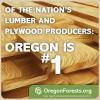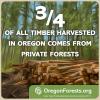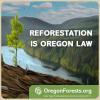-
-
-
-
-
Oregon Forestland Acreage
Oregon's total forest acreage remains fairly consistent over many decades.

-
Harvest Chart 25
Harvest of Oregon timber in the last 20+ years by forestland ownership.

-
Carbon distribution
Where is carbon distributed in the forest? Soils, living trees, roots and dead wood all hold a portion.

-
Forest sector jobs by county
How are forest sector jobs distributed throughout the state of Oregon? Let's look at each county.

-
Certified and uncertified forests
How many of Oregon's forested acres are certified under either SFI, FSC or American Tree Farm?

-
Regulations map
Different states have different regulatory systems. How does Oregon compare to other state regulations?

-
Cost of fighting fires
The cost of fighting fires in Oregon continue to grow, with significant increases in recent years.

-
Wildland fire acres burned
The total acres burned by wildfires in Oregon has increased dramatically in recent years.

-
Forest growth, removal and mortality
When comparing the growth in Oregon's forests to the removal and death of trees in the forest, Oregon continues to increase the volume of wood year over year.

-
Plywood leader
Oregon continues to lead the nation in plywood production.

-
Engineered wood leader
Oregon continues to lead the nation in engineered wood products.

-
Softwood lumber leader
Oregon continues to lead the nation in the production of softwood lumber.

-
Forest ownership table
Ownership of Oregon's is split between federal, state, private and tribal owners. This table shows the acreage in each of the ownership categories

-
Ownership pie chart 25
One third of Oregon's forests are privately owned, and yet they product three quarters of our lumber supply. These pie charts show the comparison between ownership and harvest in Oregon.

-
Total acreage pie chart
Nearly half of Oregon is covered in forestland, totaling almost 30 million acres.

-
Jobs in Oregon's forest sector table
Oregon's forest sector supports more than 62,000 jobs across the state, including forest management, primary and secondary forest products, transportation and more.





